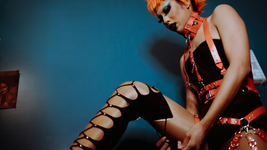Review: 'A World in Common: Contemporary African Photography' – A Lacklustre Mix Of Greatest Hits
- Ernest Chlopicki
- Jul 8, 2023
- 4 min read
Updated: Jul 10, 2023
★★★☆☆

Mario Macilau, Breaking News from The Profit Corner series, 2015. Archival pigment print on cotton rag paper. © Mário Macilau, Courtesy Ed Cross Fine Art.
As an aesthetic, Afrofuturism has been on the lips of culture so frequently that it might as well be considered retrograde. And if it draws on the African past to depict a liberated future for the Black Atlantic, the looming threat of climate crisis has put in question any future at all, for anyone. Yet as a conceptual strategy, Afrofuturism is thriving: its tools, imagined by writers such as Kodwo Eshun, serve to rework and revise the oppressive conditions that came to define lives of Afrodiasporic communities.
In this context, the Tate Modern’s newest curation, A World in Common, is an attempt at reclaiming the power of the photographic apparatus. Yet, if the methodology of Afrofuturism can be thought of as ‘remixing’ of sorts, then the Tate makes for a questionable DJ - one that relies on pre-made playlists rather than a proper mixing board. Still, within such curatorial diffidence lurks a collection of brilliant works.
On its walls, the exhibition stubbornly asserts that the aim is to examine the past and shape the future, yet the most successful aspects of A World in Common are firmly rooted in the titular contemporary. Such is the case with Sabelo Mlangeni’s Country Girls, a series of portraits capturing gay existence in South African countryside, which is most powerfully experienced without Tate’s guiding mission of intermingling timelines. Here are these beautiful people: queens and queers standing proudly, dancing, laughing, burying their loved ones. If the camera was ever used to deny their livelihoods, this history is now absent. Instead, Mlangeni’s photographs touchingly celebrate the joy of black queerness in the present moment.

Ruth Ossai, Student nurses Alfrah, Adabesi, Odah, Uzoma, Abor and Aniagolum. Onitsha, Anambrastate, Nigeria, 2018. Photograph, inkjet print on paper; 1016 × 673 mm. © Ruth Ginika Ossai.
Similar sentiment of embracing the present ‘for what it is’ can be found in the works of the UK-born Ruth Ginika Ossai. Her backgrounds have a specific feel to them: inspired by the special effects featured in Igbo gospel music videos and Nollywood films, Ossai captures sets that (brilliantly) evoke a more low-brow and camp version of Rodarte lookbooks. In doing so, the artist puts individual agency to the fore – and so we witness portraits of Nigerian friends choosing what to wear and how to pose, resulting in personal storytelling that is both heart-warming and completely honest.
Effectively, the Tate brings together a collection of potent works that fall short of their curatorial promises. In a way, that is to be expected: how do we begin to conceive the weight of neo-colonialism and extractive capitalism and consider a restorative solution all in one space? That is a task that some of the displayed artists do not have an intention of tackling.
Take Fabrice Monteiro, for instance, who in his The Prophecy series seeks to find a common denominator between the urgency of environmental collapse, Senegalese animism, and fashion editorials. These photographs do not dream of a new society (as the Tate suggests), and neither do they dance on the fine line between utopia and dystopia. Rather, they reflect on what it means to be human under a crisis of our own making. Here, the Anthropocene is represented through a visual symbiosis between human-like figures and piles of rubbish, producing something akin to mythological gods of garbage, all directed under a trained eye of a fashion industry runaway. Monteiro’s photographs are as impressive as they are terrifying, and if there is any moralism to be taken out of them, that is for the viewer to decide. And while Achille Mbembe’s guiding idea of ‘a world in common’ advocates for African histories to be understood as part and parcel of a global narrative of civilisation, we cannot forget about the Freudian suggestion that civilisation is, in fact, a construct meticulously designed to disguise our destructive animalistic tendencies. It is in the all-too-real surrealism of Monteiro’s photographs that these tendencies come to light: they are our commonplace.

Installation View, Edson Chagas,Tipo Passe 2014 atA World In Common: Contemporary African Photography, Tate Modern 2023. © Tate Photography, Lucy Green. Courtesy of the artist and Apalazzo Gallery.
If there are moments that live up to the exhibition’s conceptual ambitions, they are indeed located in this merging of the spiritual with the photographic. When we look at works such as Edson Chagas’s Tipo Passe series, it all makes sense. Here, the array of individuals wearing traditional Bantu masks is photographed in a way that meets Portuguese passport/visa photo requirements – facing the camera against a stark white background. These cultural artifacts are divorced from their intention, yet their inclusion challenges the oppressive history of the camera as a tool of pseudoscientific racism. These simple portraits suggest the Middle Passage, UK immigration laws, ancestral history, spiritual protection, identity. It is one of the rare instances where Tate’s curation serves as a powerful amplifier. It’s a shame, for A World in Common is composed of powerful pieces that deserve to be seen. It might be laughable to offer becoming one’s own DJ as an advice in how to approach this exhibition, but not unreasonable. After all, that is what the Afrofuturists advocate for.
'A World in Common: Contemporary African Photography' is on at the Tate Modern until 14 January 2024.
Tate Collective Members (16-25) go for £5.
Edited by Samuel Blackburn


































コメント